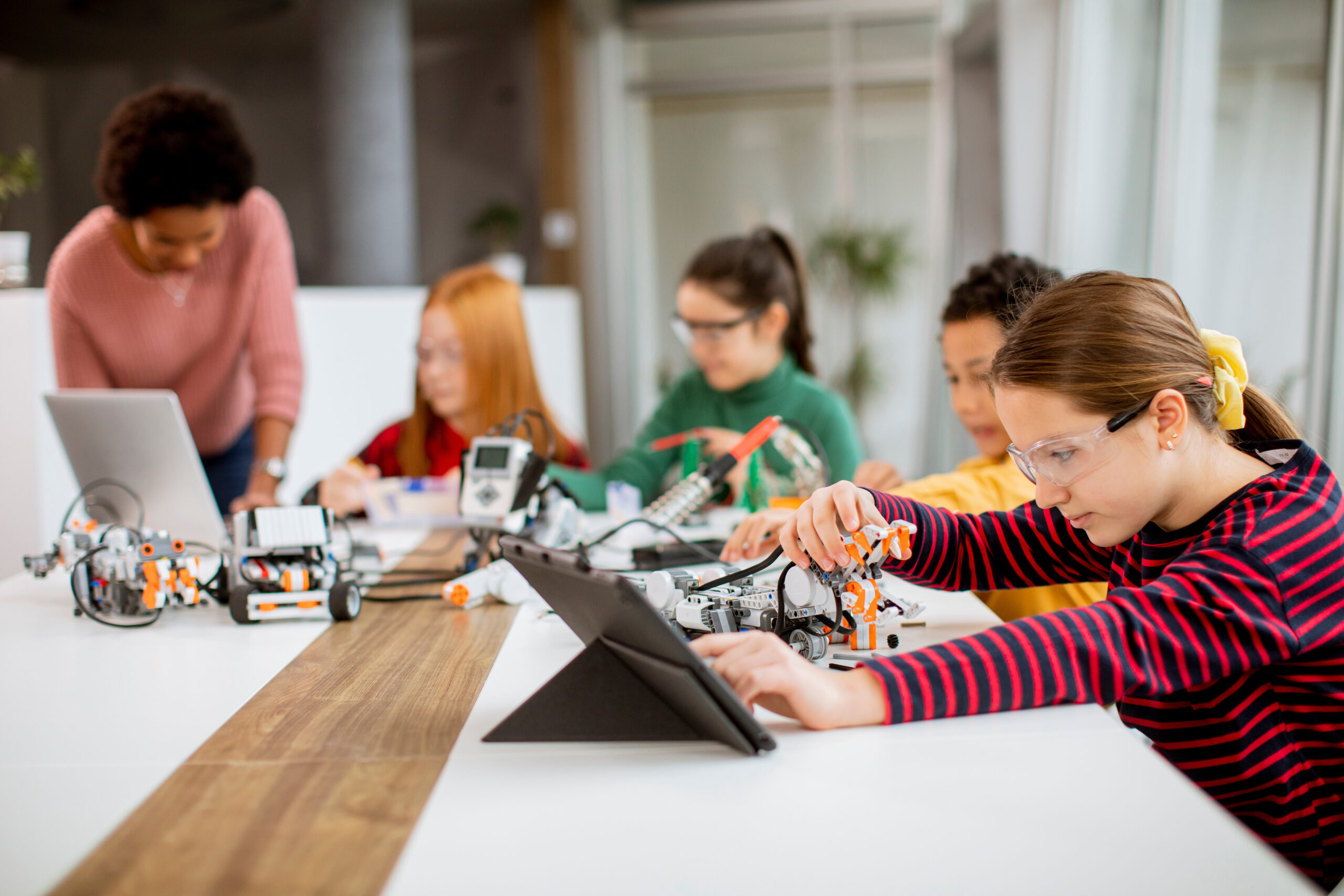How can STEM education empower the next generation of innovators? What role does creativity play in STEM education? How can early exposure to STEM education impact lifelong learning and career success?
This blog explores how STEM education is vital for shaping creative, critical thinkers ready to tackle the challenges of tomorrow. With rapid technological advancements reshaping industries, fostering an early love for science, technology, engineering, and math is more important than ever. The piece highlights how hands-on learning, problem-solving, and encouraging curiosity can unlock a student’s full potential and help them envision themselves as future innovators.
From integrating arts into STEM to advocating for mentorship and inclusive access, the post outlines a dynamic roadmap for making STEM education more equitable and inspiring. Readers will gain insights into the power of early exposure, real-world application, and interdisciplinary collaboration—all crucial elements for empowering today’s youth to become tomorrow’s trailblazers.
Science, technology, engineering, and mathematics, or STEM, is more than just a collection of topic areas for students to study. It’s a robust, innovative field with an exceptionally high demand.
Today’s world is becoming more tech-driven by the day, with tools like automation and artificial intelligence reshaping industries and impacting our lives on a daily basis. With that, the need for STEM education is more important than ever, and encouraging youth to pursue this field is one of my biggest goals as an inventor advocate.
According to the Bureau of Labor Statistics, STEM employment is increasing significantly and is set to outpace all other occupations between now and 2033. In the digital age, STEM is the foundation for innovation and invention, which is why we must not only teach youth the technical knowledge of the field but also encourage them to be curious, explore, and dare to think differently. The earlier we introduce young minds to STEM, the more we can foster a positive learning environment that champions experimentation and creative thinking, empowering the next generation of problem-solvers.
In this blog, we’ll explore how STEM education is essential in nurturing critical thinking, creativity, and innovation and how educators, parents, and industry leaders can collaborate to support youth in their pursuit of knowledge and discovery.
Table of Contents:
The Role of STEM in Cultivating Critical Thinking
Importance of Hands-On Learning
Fostering Creativity & Innovation in STEM Learning
The Intersection of STEM with the Arts & Humanities
The Importance of Early Exposure to STEM
The Impact of Mentorship & Role Models
Overcoming Barriers to STEM Education
The Role of STEM in Cultivating Critical Thinking
STEM education is about understanding problems and developing creative solutions for them. It differs wildly from other academic disciplines that thrive on memorization and more rote learning methods. Instead, STEM encourages critical thinking and analytical skills—the same essential skills that drive most scientific breakthroughs, technological advancements, and impressive engineering feats. Often, no two problems are the same, which means each solution must be approached with a fresh, creative point of view.
STEM & Problem-Solving
Because the problems STEM professionals face are so varied, STEM education challenges students to break down the problems and analyze patterns and trends to develop the most logical solutions. Whether it’s learning to code a program, design a prototype, or hypothesize and conduct an experiment, STEM teaches students to approach problems systematically, much like engineers and scientists in the field do.
Every problem can be approached with a process or system that makes the journey to a solution more streamlined. Think of the scientific method, for example. The tried-and-true process starts by identifying a question you want to investigate. Then, you conduct some research and make observations to form your hypothesis. Next, you test your hypothesis by gathering data and conducting experiments. Once you have the data, you analyze it and look for patterns before finally drawing your conclusion. For centuries, scientists have used this method to lead their discoveries. That said, remember that STEM isn’t a rigid field. It thrives on creativity and innovative thinking. Processes like the scientific method or other long-standing techniques aren’t required or the only option. STEM educators should teach these principles but also encourage students to throw them out when they’re not working, when more “outside of the box” thinking is what’s actually needed to solve a problem.
Importance of Hands-On Learning
STEM isn’t one of those disciplines you can master by simply reading a textbook and taking notes. One of the most effective ways to teach STEM is actually through hands-on, experiential learning. Programs like the FIRST Robotics Competition and the Young Inventors Showcase allow students to build, test, and refine their ideas in real-time.
There is immense potential in allowing youth to take their ideas outside the traditional classroom and explore them in a collaborative, supportive environment that encourages them to really get their hands dirty. Hands-on learning helps students learn perseverance and adaptability, preparing them for what it’s like to work as scientists or engineers in the real world.
Learning from Failure
Failure is an essential part of innovation. Great inventions often don’t just happen. They result from countless tests, trials, and failures—sometimes over several years—to finally reach the end product.
A crucial aspect of STEM education is encouraging students to view failure not as a setback but as an opportunity to learn and grow. When students are supported to experiment, test, and iterate their ideas and solutions, they develop greater resilience, confidence, and problem-solving skills that extend beyond what can be taught in a classroom. Sometimes, their failures can lead to new ideas they may have missed otherwise, creating a cycle of innovation.
Fostering Creativity & Innovation in STEM Learning
For STEM education to be truly impactful, it has to go beyond technical skills. Creativity and a willingness to explore are skills just as important as logic and precision for success in the field. The world’s greatest scientific and technological advancements weren’t born from textbooks or rigid curricula. Computers, smartphones, ChatGPT, and so on were all developed with bold, creative thinking.
Children, especially, are natural explorers. They’re far more inquisitive and excited by their environment than most adults, which is why continuously encouraging them to be curious and explore the world around them is so essential, particularly in STEM fields. Programs that blend structured learning with open-ended exploration give students the freedom to discover new interests, creatively problem-solve, and feel more confident in thinking outside the box.
The Intersection of STEM with the Arts & Humanities
Gone are the days when STEM was an isolated discipline fully separate from the arts and humanities. STEM is actually increasingly including the arts, leading to the creation of the STEAM acronym—science, technology, engineering, arts, and mathematics.
The “arts” is a broad term encompassing several focuses, including language arts, drama, graphic design, visual arts, music, and other media. STEAM also emphasizes the importance of valuable soft skills, such as communication and collaboration.
Integrating design, storytelling, and artistic expression into traditional STEM education encourages greater innovation in fields such as architecture, user experience (UX) design, and digital media. This is a key strategy in making STEM education more engaging and interdisciplinary, broadening its appeal to help reach more students and further exemplify its relevance in every aspect of life.
The Importance of Early Exposure to STEM
The earlier we can introduce STEM concepts, the better. Early exposure to STEM education helps children develop their curiosity, creativity, and problem-solving skills, all while nurturing their love for exploration and setting a strong foundation for future learning. The sooner youth are introduced to STEM in their school careers, the more likely they’ll be to pursue careers in the field.
For young minds, the best way to get them engaged with STEM early on is to present them with fun, interactive activities and curriculum. A large part of this is educational technology, which has completely revolutionized the STEM learning experience, not only making it more engaging but more accessible, too. There are several tools available for both educators and parents to use, including:
- LEGO Bricks, robotics, and Arduino kits for hands-on engineering experiences.
- Coding platforms like Scratch and Python to teach programming early.
- Virtual reality (VR) and augmented reality (AR) to create immersive learning experiences that transcend the classroom’s capabilities.
The Impact of Mentorship & Role Models
Youth especially need strong role models. Representation is incredibly important here. Students want to see successful STEM professionals who look like them. This makes them more likely to believe in their own potential and gives them someone to look toward for guidance, inspiration, and even reassurance when the going gets tough. This is why diversity in STEM across genders, races, socioeconomic backgrounds, and so on is so crucial, particularly when aiming to inspire the next generation of innovators.
Similarly, mentorship programs are essential for connecting students with professionals, university researchers, and industry leaders who can provide guidance, encouragement, and real-world insights into the STEM field. Youth can look for mentorship opportunities at local universities, career fairs, local organizations, or even online groups.
Overcoming Barriers to STEM Education
Despite STEM’s growing demand and relevance, STEM education still has barriers to overcome. Many students lack access to quality STEM programs, especially for underfunded schools and underrepresented communities. Closing this gap requires:
- Increased investment in STEM education programs.
- Corporate sponsorship and government funding for schools in low-income areas.
- Scholarship and grants for students who attend STEM camps and competitions.
Beyond closing the resource gap, diversity and inclusion is an ever-present issue as the STEM workforce still struggles with gender and racial disparities. Women comprise 35% of the STEM workforce and are the minority in major tech companies, including Amazon, Meta, Apple, Google, and Microsoft. Encouraging more women and underrepresented groups to pursue STEM education and careers is vital and requires intentional efforts, such as:
- Targeted outreach programs in schools and communities.
- STEM mentorship initiatives that match students with diverse role models they can connect with.
- Creating inclusive learning environments where every single student feels welcome and supported.
Another key challenge STEM faces is bridging the gap between education and real-world applications. Traditional education is often focused on theoretical knowledge rather than practical applications. It can be challenging for some students to make the connection between what they’re learning and how they can use that information in their real lives. These feelings often come up in math classes, where you may hear students ask, “Why is this important?” or “When am I ever going to use this?”
One way to bridge this gap is with industry partnerships with local schools. These partnerships can help overcome barriers to STEM education by:
- Providing real-world STEM challenges for students to solve that go beyond the classroom.
- Offering internships and apprenticeships to expose students to more career possibilities in the industry.
- Encouraging project-based learning that mirrors actual STEM work.
While there are certainly barriers blocking some students from pursuing STEM careers, they aren’t impossible to overcome. With intention, planning, and collective action from educators, parents, and industry leaders, we can help get more youth engaged and interested in the field.
The Future of STEM Education
One of the best parts of STEM education is its evolutionary nature. The field constantly changes, particularly as new technological advancements emerge. Consider technologies like AI, 3D printing, and more advanced robotics and how they’ve all impacted how students learn and interact with information. These innovations make the STEM field more dynamic, personalized, and globally accessible.
In the future, we’ll also likely see more interdisciplinary STEM education beyond just including the arts. STEM is about solving complex, real-world problems, which requires reaching across disciplines to create the most well-rounded education possible. This could include collaborating with other fields like biotech and environmental science, as well as opening the door for more cross-disciplinary innovation where engineers, designers, and even entrepreneurs all work together.
Conclusion
STEM education is the key to empowering the next generation of innovators and creating a class of problem-solving, creative thinkers who can develop solutions for the future’s most pressing issues. Teaching STEM is about more than just producing more scientists and engineers to fill open positions. It’s about encouraging youth to preserve the future of innovation and invention.
When we make STEM accessible, inclusive, and engaging for young learners, we inspire them to dream bigger, think bolder, and create innovative solutions and discoveries that will shape our future. Whether through robotics competitions, mentorship, hands-on learning, or interdisciplinary collaboration, the opportunities to ignite curiosity and innovation are endless.
Tomorrow’s breakthroughs start with the education we provide today. Now is as good a time as any to begin investing more in STEM education to support the next generation of leaders and big thinkers.




